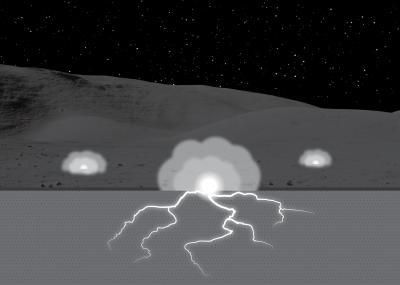The moon appears to be a tranquil place, but modeling done by University of New Hampshire (UNH) and NASA scientists suggests that, over the eons, periodic storms of solar energetic particles may have significantly altered the properties of the soil in the moon's coldest craters through the process of sparking—a finding that could change our understanding of the evolution of planetary surfaces in the solar system.
The study, published August 8 in the Journal of Geophysical Research-Planets, proposes that high-energy particles from uncommon, large solar storms penetrate the moon's frigid, polar regions and electrically charge the soil. The charging may create sparking, or electrostatic breakdown, and this "breakdown weathering" process has possibly changed the very nature of the moon's polar soil, suggesting that permanently shadowed regions, which hold clues to our solar system's past, may be more active than previously thought.
"Decoding the history recorded within these cold, dark craters requires understanding what processes affect their soil," said Andrew Jordan of the UNH Institute for the Study of Earth, Oceans, and Space and lead author of the paper. "To that end, we built a computer model to estimate how high-energy particles detected by the Cosmic Ray Telescope for the Effects of Radiation (CRaTER) instrument on board NASA's Lunar Reconnaissance Orbiter (LRO) can create significant electric fields in the top layer of lunar soil."

This illustration shows a permanently shadowed region of the moon undergoing subsurface sparking (the 'lightning bolts'), which ejects vaporized material (the 'clouds') from the surface. Subsurface sparking occurs at a depth of about one millimeter. Image not to scale.
(Photo Credit: Andrew Jordan/UNH)
The scientists also used data from the Electron, Proton, and Alpha Monitor (EPAM) on the Advanced Composition Explorer. CRaTER, which is led by scientists from UNH, and EPAM both detect high-energy particles, including solar energetic particles (SEPs). SEPs, after being created by solar storms, stream through space and bombard the moon. These particles can buildup electric charges faster than the soil can dissipate them and may cause sparking, particularly in the polar cold of permanently shadowed regions—unique lunar sites as cold as minus 240 degrees Celsius (minus 400 degrees Fahrenheit) that may contain water ice.
"Sparking is a process in which electrons, released from the soil grains by strong electric fields, race through the material so quickly that they vaporize little channels," said Jordan. Repeated sparking with each large solar storm could gradually grow these channels large enough to fragment the grains, disintegrating the soil into smaller particles of distinct minerals, Jordan and colleagues hypothesize.
The next phase of this research will involve investigating whether other instruments aboard LRO could detect evidence for sparking in lunar soil, as well as improving the model to better understand the process and its consequences.
"If breakdown weathering occurs on the moon, then it has important implications for our understanding of the evolution of planetary surfaces in the solar system, especially in extremely cold regions that are exposed to harsh radiation from space," said coauthor Timothy Stubbs of NASA's Goddard Space Flight Center in Greenbelt, Maryland.
Source: NASA/Goddard Space Flight Center